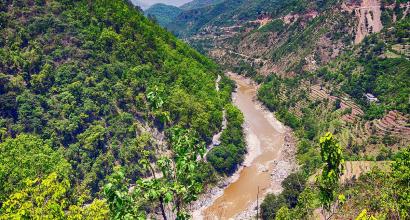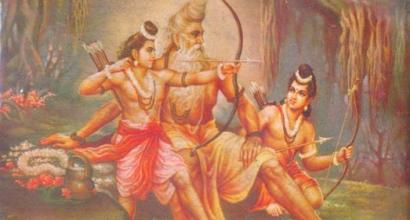Rāma was delighted hearing Hanūmān’s faithful account of the events in Laṅkā. He said, “Hanūmān has executed the tremendous task entrusted to him by his master, Sugrīva. He has saved all of us – the Raghuvaṃśa, Lakṣmaṇa, and myself – by finding Sītā. What pains me is my inability to gift him the kind of joy he has just given me. Let this embrace, which is the only wealth I possess now, stand for the gift of my own Self to this noble Hanūmān. Now, however, the thought of crossing the mighty ocean troubles me. How will the vānaras reach the father shore of the ocean?”
Sugrīva tried to dispel Rāma’s sorrow. He said, “Give up these paralysing thoughts, just as a man of resolute mind gives up thoughts that impede his purpose. You are wise, learned, and steadfast. You should see that a bridge is built across the ocean. The moment we see Laṅkā situated atop the Trikūṭa Mountain, Rāvaṇa is as good as slain. Grief saps man’s valour. Resort to your sattva and rely on your valour. As you have entrusted your mission to the vānaras, it will certainly not fail! An inactive kṣatriya fails, but everyone fears the courageous. The vānaras are capable of warfare and can take any form at will. They will vanquish the enemy using boulders and trees. We will somehow cross over the ocean. Your mission will certainly be successful!”
Rāma agreed with Sugrīva and Hanūmān to relate in detail the defence mechanism in Laṅkā as well as the strength of the rākṣasa army. Hanūmān then started describing, “The city of Laṅkā is full of chariots and powerful elephants. It has four entrance gateways which are protected by gates, firmly fastened with strong iron bars. They have devices for hurling stones on attackers and are also equipped with hundreds of śataghnis. The fortifications are made of gold and it is impossible to scale them. All around are deep moats filled with cold water and fierce crocodiles. Four bridges lead to the gateways and are protected by war machines. Enemy troops will be pushed into the moats, without doubt. Rāvaṇa is under his own control and is always ready for battle; he is vigilant and constantly motivates his troops. No one can scale Laṅkā’s citadel; it is protected by rivers, mountains, forests, and defensive structures. Each gate is guarded by thousands of rākṣasas. But, I have smashed the bridges and filled in the moats. I have burned the city and have reduced its ramparts to the ground. With me, Aṅgada, Dvivida, Mainda, Jāmbavān, Panasa, Nala, and Nīla on your side, you will not need anyone else’s help. We await your command! You may select an auspicious muhūrta and command us to set forth!”
Rāma declared, “I can destroy the city of Laṅkā right away and this is the best muhūrta to march forth; the Sun is at his zenith in the skies and the muhūrta called Vijaya is at hand. Today is the day of Uttaraphalgunī and tomorrow, the Hasta begins. Nīla! Head before us, accompanied by a hundred thousand vānaras. You must scout the way and lead your army through a path rich in fruits, roots, and honey as well as cool forests and water bodies. Watch out for rākṣasas hiding in caves, groves, and thickets. Let Ṛṣabha guard the right segment of the army and Gandhamādana, the left. I will lead the army from the centre, riding on Hanūmān. May Jāmbavān, Suṣeṇa, and Vegadarśī guard the rear. Sugrīva commanded his army accordingly and all groups of vānaras emerged from their caves and mountaintops, eager for battle. Rāma and Lakṣmaṇa thus started in the Southern direction, followed closely by the vānaras.
The vānaras followed Rāma with immense alacrity. In their wild excitement, they carried each other on their backs; but then, one would suddenly throw down the other and then leap up to knock down others. The fearsome army of vānaras, which resembled a mighty ocean, streamed forward with a mighty roar. Lakṣmaṇa, who was riding on Aṅgada’s shoulders observed many favourable omens and assured Rāma of their victory. The army passed through the Sahya and the Malaya mountains and arrived at the Mount Mahendra. Going ahead from there, they reached the vast shore of the ocean. Upon the instruction of Rāma, the army of the vānaras camped on the densely wooded seashore.
Looking at the ocean that is filled with serpents, crocodiles, and sharks, the vānaras fell into despair. They found it unapproachable and impossible to cross. The ocean looked just like the sky, and the sky was like the ocean – the two were indistinguishable; ocean’s water merged into the sky and the sky into the water. With its leaping waves and roaring waters, the ocean appeared to have gone mad.
Rāma grieved to Lakṣmaṇa, who was by his side, “It is said that sorrow decreases with the passage of time; but mine only increases day by day; I am not sad because my beloved is far away from me, nor because she is abducted; I am in great agony, as her youth is wasting away. O breeze! Touch my beloved, and the come, touch me; through you, we will derive the joy of touching each other’s bodies and in the moon, our eyes will meet. I am being burnt by the fire of love, Saumitri, and will jump into the ocean to quench the fire. I am only surviving because I know that the beautiful lady, my beloved, still share the same earth. I am surviving like a parched paddy field that draws water from another well-watered field. Ah! When will I defeat my foes and when will I gaze at her lovely face? And when will I kiss her face with its beautiful lips, just as a sick person might drink a powerful medicine. When will the pious lady embrace me?”
Even as he was lamenting thus, the Sun set. Rāma performed the sandhyāvandana, with his mind still preoccupied with Sītā .
~
In the meanwhile, Rāvaṇa examined the dreadful havoc that Hanūmān had wrought in Laṅkā. With his face downcast in humiliation, he addressed the rākṣasas, “That mere vānara not only managed to lay waste the impregnable city but also discovered Jānakī. What should I do now? It is said that there are three types of men in this world: the superior, the inferior, and those in between. The superior ones first take counsel from competent friends and advisors, and only then undertake a task. The middle ones, reflect upon matters by themselves and carry out their actions. The inferior ones undertake actions, without examining the pros and cons; he cares little for the daiva, and then fails to finish his task. Just as men are of three kinds, it is said that counsel itself is of three kinds as well. The best kind of counsel comes about when the advisors are consistently of one mind and adhere to the insights provided by śāstras; the middling kind of counsel is one which is arrived at unanimously, though the counsellors harboured different opinions previously; the worst counsel is one which involves a lot of debate between the advisors, who never arrive at a conclusion. Thus, my dear counsellors, please advise me appropriately, for Rāma will soon attack the city of Laṅkā accompanied by innumerable vānaras. He will surely cross over the ocean as he is equipped with the strength and the skill to do so.”
The rākṣasas reassured their lord that Rāma’s strength could not match his; they reminded Rāvaṇa of his extraordinary feats. The best of the rākṣasas such as Prahasta, Durmukha, Vajradaṃṣṭra, Nikumbha, and Vajrahanu as well as Indrajit, Rāvaṇa’s son, declared that they would singlehandedly face Rāma and the vānaras. They all rose, picking different weapons in their hands, but Vibhīṣaṇa stopped them saying, “The wise have advised the use of force only under circumstances where the other three stratagems do not help. How can we assail someone who is vigilant, strong, and unassailable? Who would have imagined that a vānara would leap across the ocean? Let us not underestimate our foes. And has Rāma wronged the king of rākṣasas, for him to abduct that great man’s wife from Janasthāna? Vaidehī poses grave danger to us; she, who has been abducted must be surrendered at all costs. Let us not unnecessarily provoke quarrel; we should not engage in pointless hostility with the powerful man. If you do not free Rāma’s beloved wife of your own accord, the entire city of Laṅkā and its rākṣasas will perish. Give up your wrath, that destroys both pleasure and dharma; follow dharma that is conducive to joy and fame.”
Advised this way by Vibhīṣaṇa, Rāvaṇa was enraged, and spoke as if impelled by his own doom. He said, “It is easier to live with one’s enemy or a venomous serpent, but never with a deceptive friend who favours the foe. I very well know the nature of relatives around the world; kinsmen take pleasure in each other’s sufferings. They conceal their true feelings and are sources of danger. Vibhīṣaṇa! You probably cannot stand the fame and respect that I have gained in the three worlds. You are a disgrace to our family!”
Thus addressed by Rāvaṇa, Vibhīṣaṇa, with a mace in his hand, jumped up into the air with four other rākṣasas. Roused to anger, he spoke these words to his brother, the lord of rākṣasas, “You are my brother, O king and you may speak to me as you like, but I cannot stand these false accusations and abusive words. Those who have no control over their self and are already under the power of Death, do not pay heed to sane advice. It is easy to find men who will say what pleases you, but it is hard to find a person who will say or listen to what is unpleasant, but appropriate. I have rendered my advice to you and would not like to see you slain by Rāma. Take care of yourself and this land. Svasti! I am leaving. May you be happy without me!”
The moment Vibhīṣaṇa uttered these words, he, along with four rākṣasas, went to the place where Rāma and Lakṣmaṇa had camped with the vānaras. Looking at them, Sugrīva deliberated for a moment and declared to the vānaras that the rākṣasas were surely approaching to kill them. Vibhīṣaṇa, addressed Sugrīva and the other vānaras, even as he was still hovering in the sky, “I am the younger brother of Rāvaṇa, the king of rākṣasas; he abducted Sītā and has imprisoned the helpless lady. I repeatedly advised him to return Sītā to Rāma, but he would not listen to me, just as a dying man refuses his medicine. Therefore, I have given up my wife and sons, and have come seeking refuge with Rāghava. Please inform him that, I, Vibhīṣaṇa have come to him, seeking shelter.”
Listening to these words, Sugrīva spoke to Rāma in the presence of Lakṣmaṇa, “Vibhīṣaṇa, the younger brother of Rāvaṇa, along with four other rākṣasas, has come seeking refuge in you. You must realise that Rāvaṇa has sent his younger brother here as a spy. You know the best, but I think it would be appropriate for us to take him as a prisoner. Clad in deception, this rākṣasa will kill you once he has won your trust, Rāghava. He must be slain with harsh torture, along with his ministers, for he is the brother of the wicked Rāvaṇa!”
Upon hearing these words of Sugrīva, Rāma said to Hanūmān and the rest of the vānaras, “Sugrīva’s words make sense and you all have heard him just speak. In difficult matters, it is best to seek advice from a friend, who is intelligent, virtuous, capable, and cares for the well-being of the other.” In reply to Rāma, Aṅgada suggested that they examine precaution in welcoming Vibhīṣaṇa and said that they must befriend him only if he turns out to be virtuous and honest. Śarabha felt that they must send a spy in turn to examine Vibhīṣaṇa; Jāmbavān said that the rākṣasa must be viewed with suspicion, as he had arrived at the wrong place at the wrong time. Mainda suggested that they interrogate Vibhīṣaṇa gently about Rāvaṇa and once having understood his intentions, they would act as they wished.
Hanūmān then voiced his view, “Rāma, I am not speaking in order to prove myself better than the others or because I am fond of my own voice. I speak because of the gravity of the situation. I perceive a serious problem in the advice your counsellors have just uttered. On the one hand, we cannot know if Vibhīṣaṇa is trustworthy unless we employ him, and on the other, it would be foolish to engage with him too hastily. I don’t think this is the wrong time and place to come; in fact, it is the best time to switch sides – he has abandoned an evil person and has come to support the dhārmic one. Furthermore, the counsellors just said that he must be interrogated by a spy; however, we must keep in mind that any intelligent person who is interrogated will immediately become suspicious of the questions. Thus, we might risk alienating a person, who would have otherwise been a good ally. Moreover, one cannot read another person’s mind merely by his words. So far, the rākṣasa has spoken with a composed mind and we haven’t observed any signs of vile nature. It is impossible to conceal facial expressions and our face invariably betrays our true emotions. He knows your might and has also heard about your killing of Vālī. He has come here also because he probably seeks the kingship of Laṅkā for himself. I have argued to the best of my ability that the rākṣasa can be trusted; you may contemplate over this, and decide the course of action.”
To be continued...
[The critically constituted text and the critical edition published by the Oriental Institute, Vadodara is the primary source. In addition, the Kannada rendering of the epic by Mahāmahopādhyāya Sri. N. Ranganatha Sharma and the English translation by Sri. N. Raghunathan have been referred.]














































